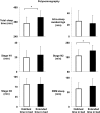Beneficial impact of sleep extension on fasting insulin sensitivity in adults with habitual sleep restriction
- PMID: 25348128
- PMCID: PMC4402666
- DOI: 10.5665/sleep.4660
Beneficial impact of sleep extension on fasting insulin sensitivity in adults with habitual sleep restriction
Abstract
Study objectives: A link between sleep loss and increased risk for the development of diabetes is now well recognized. The current study investigates whether sleep extension under real-life conditions is a feasible intervention with a beneficial impact on glucose metabolism in healthy adults who are chronically sleep restricted.
Design: Intervention study.
Participants: Sixteen healthy non-obese volunteers (25 [23, 27.8] years old, 3 men).
Interventions: Two weeks of habitual time in bed followed by 6 weeks during which participants were instructed to increase their time in bed by one hour per day.
Measurements and results: Continuous actigraphy monitoring and daily sleep logs during the entire study. Glucose and insulin were assayed on a single morning blood sample at the end of habitual time in bed and at the end of sleep extension. Home polysomnography was performed during one weekday of habitual time in bed and after 40 days of sleep extension. Sleep time during weekdays increased (mean actigraphic data: +44 ± 34 minutes, P < 0.0001; polysomnographic data: +49 ± 68 minutes, P = 0.014), without any significant change during weekends. Changes from habitual time in bed to the end of the intervention in total sleep time correlated with changes in glucose (r = +0.53, P = 0.041) and insulin levels (r = -0.60, P = 0.025), as well as with indices of insulin sensitivity (r = +0.76, P = 0.002).
Conclusions: In healthy adults who are chronically sleep restricted, a simple low cost intervention such as sleep extension is feasible and is associated with improvements in fasting insulin sensitivity.
Keywords: QUICKI; fasting glucose; fasting insulin; insulin resistance; insulin sensitivity; sleep extension; sleep loss; time in bed; type 2 diabetes.
© 2015 Associated Professional Sleep Societies, LLC.
Figures




Comment in
-
Additional Sleep Duration Associates with Improved Blood Sugar Regulation.Sleep. 2015 May;38(5):663-4. doi: 10.5665/sleep.4648. Sleep. 2015. PMID: 26199963 Free PMC article. No abstract available.
References
-
- Kripke DF, Simons RN, Garfinkel L, Hammond EC. Short and long sleep and sleeping pills. Is increased mortality associated? Arch Gen Psychiatry. 1979;36:103–16. - PubMed
-
- National Sleep Foundation. 2013 International Bedroom Poll. 2013
-
- International Diabetes Federation. IDF Diabetes Atlas. 6th ed. Brussels, Belgium: International Diabetes Federation; 2013. - PubMed
-
- Harris MI. Diabetes in America: epidemiology and scope of the problem. Diabetes Care. 1998;21(Suppl 3):C11–4. - PubMed
Publication types
MeSH terms
Substances
LinkOut - more resources
Full Text Sources
Other Literature Sources
Medical

